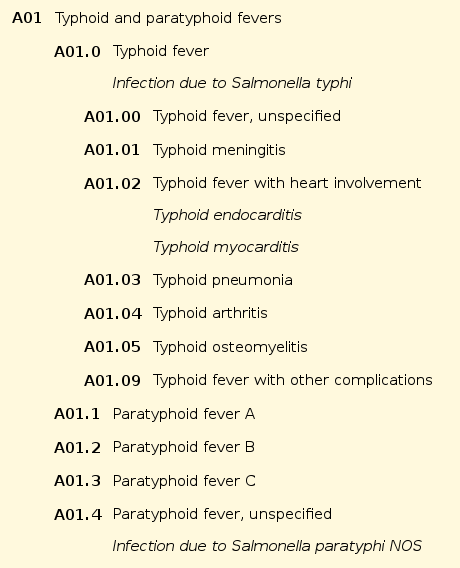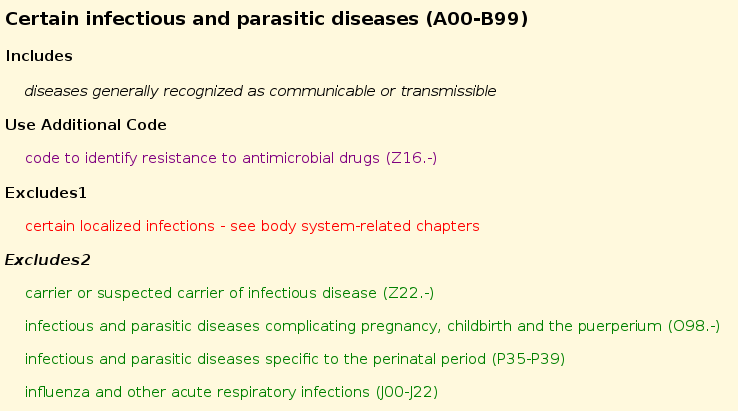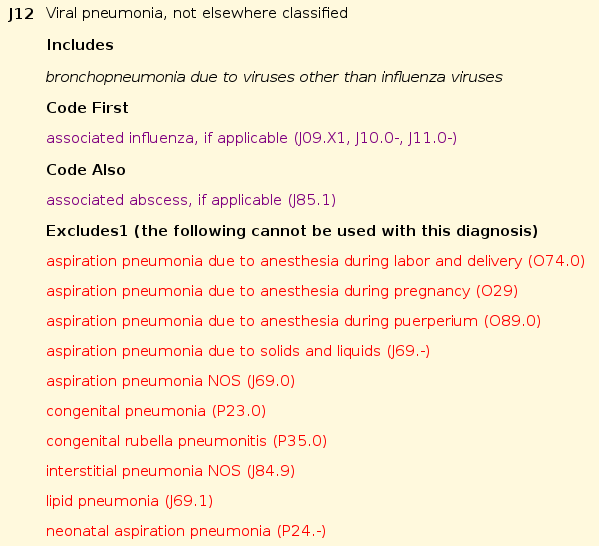You should have at your disposal the following files, either from a book, online or on your computer:
Depending on what you are looking up, you may not need the last 3, but you will likely need the first 3. If you haven't already, at least lightly scan through the Guidelines, so that you have a sense of what is in there. Hint: However many you do use, you want to make use of your browser's tabs (right-click on each, then choose to open in a new tab) so that you can easily switch from one list to another. These are all large files, and in addition must be processed after downloading.
I probably shouldn't have to say it, but this advice is no more than a starting point to try to understand the peculiarities of ICD10. Perhaps the biggest reason to delve into this a bit, is to realize some of the specifics about the documentation that will be necessary for someone in your office or the hospital to appropriately select ICD10 codes.
There is some help with redirection for some term that may not be named as you might expect. For example, if you look up Neuropathy, diabetic, you find See E08-13 with .40, which at first might seem puzzling, since the nervous system codes are in the G section. It turns out that this is an example of a combination code, whereby you simultaneously code for diabetes of some type (type 1 or type 2 for example) and for the associated complication. So there is no need to code a neuropathy separately.
This also points out why using the Index is a good starting point, since you might spend some frustrating time looking for something in the wrong section, and then code it wrong.
The Index typically just gives you a starting point, telling you where in the Tabular listing to look. In many cases you are not given a complete code in the index. What I mean by "complete code" is that the files of the Tabular listing shows what are called "Valid" codes, ones which are usable for billing, and "Invalid" codes, which cannot be used. There is a general way that they are listed which tells you whether some code is a valid one. Look at this fragment:

Important! Here under Typhoid and parathyphoid fevers, we have a major category, subcategories, and some sub-subcategories. A category is not Valid (not billable), if there are any subcategories underneath it. So in this instance, Invalid codes are A01 Typhoid and paratyphoid fevers and A01.0 Typhoid fever, since these have subcategories. Valid codes are not only A01.00, A01.01, A01.02, A01.03, A01.04, A01.05, and A01.09, but also A01.1, A01.2, A01.3, and A01.4, since none of these have subcategories. To be more specific, say you have a patient with typhoid fever, without anything more specific. The correct code is A01.00, not A01.0.
Built in to the listing are some advisories that I have color-coded. Here, at the beginning of a section, we see some general advisories for that chapter:

There are explanations of these at the top of the Tabular page, and also in the Guidelines. Of particular importance are the red messages, indicating things which should not be coded in this category or section, and the green ones, which point out what sorts of conditions could be included but need to be coded separately.

Here, under a specific category, we also see some purple notes, which give advisories about some other features of the codes, which come first in a list, or which should be included if applicable.
Obviously, this will be pertinent in situations of various kinds of neoplasms. The starting point should initially be the Tabular listing, but then the Neoplasm Table should be consulted. Notice the marked difference in the resulting codes depending on whether a tumor is primary or secondary, as well as depending on its behavior.

Here we see how complete/complex/confounding ICD10 can be, as we have a hard time imagining some substance that could not be specifically coded when it caused some medical event. Yes, ICD10 says that conceivably there might be a khat poisoning as an assault.

The most important thing to point out here is that thankfully these codes need only be used when the medical encounter is specifically about the medical effects of some injury. You do not need to code this forever even when there is some permanent sequelae, if it is immaterial to the current illness or encounter. The range of injuries and their circumstances is quite astounding.
You really should, once you have made your list of codes, go to the appropriate part of the Guideline to look for any further information about how to code selected situations. These are not extensive, and once we all get used to and remember what's there, won't be so necessary.